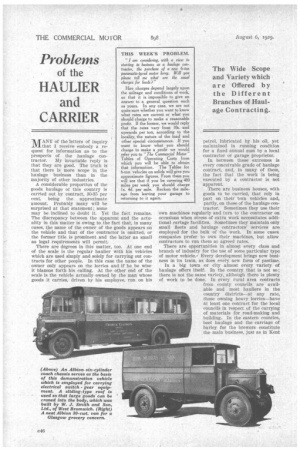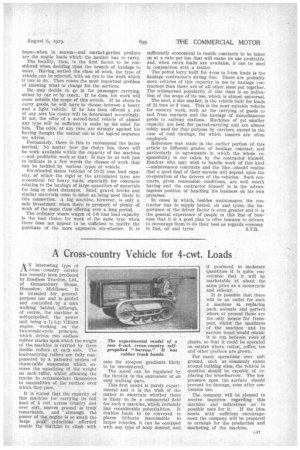Problems
Page 70

Page 71

If you've noticed an error in this article please click here to report it so we can fix it.
of the
HAULIER and CARRIER
MANY of the letters of inquiry that I receive embody a request for information as to the prospects of the haulage con
tractor. My invariable reply is that they are good. The truth is that there is more scope in the haulage business than in the majority of other industries.
A considerable proportion of the goods haulage of this country is carried out by contract, 30-35 per cent, being the approximate amount. Probably many will be surprised at that statement; some may he inclined to doubt it. Yet the fact remains. The discrepancy between the apparent and the actuality in this matter is owing to the fact that, in many cases, the name of the owner of the goods appears on the vehicle and that of the contractor is omitted, or the former title is prominent and the latter as small as legal requirements will permit.
There are degrees in this matter, too. At one end of the scale is the regular haulier with his vehicles which are used simply and solely for carrying out contracts for other people. In this case the name of the owner only appears on the lorries and if he be wise it blazons forth his calling. At the other end of the scale is the vehicle actually owned by the man whose goods it carries, driven by his employee, run on his petrol, lubricated by his oil, yet maintained in running condition for a fixed annual sum by a local contractor or garage proprietor.
In between these extremes is every conceivable grade of haulage contract, and, in many of them, the fact that the work is being executed by a contractor is not apparent.
There are business houses, with goods to be carried, that rely in part on their twn vehicles and, partly, on those of the haulage contractor. Sometimes they use their own machines regularly and turn to the contractor on occasions when stress of extra work necessitates additional cartage facilities. Sometimes they maintain only small fleets and haulage contractors' services are employed for the bulk of the work. In some cases companies prefer to own their machines, but allow contractors to run them at agreed rates.
There are opportunities in almost every class and branch of industry for the use of some particular type of motor vehicle., Every development brings new business in its train, as does every new form of pastime.
In a big town or city almost every variety of haulage offers itself. In the country that is not so; there is not the same variety, although there is plenty of work to be done. In every rural area contracts Prom county councils are available and most hauliers in the country districts—at any rate, those owning heavy lorries—have at least one contract for the local councils in respect of the carrying of materials for road-making and building. In the eastern counties, beet haulage and the carriage of barley for the brewers constitute the main business, just as in Kent
hops—when in season—and market-garden produce are the staple loads which the haulier has to carry. The locality, then, is the first factor to be considered when deciding upon the branch of haulage to enter. Having settled the class of work, the type of vehicle can be selected, with an eye to the work which it has to do. Then comes the most important problem of knowing what to charge for the services. He may decide to go in for passenger carrying, either by car or by coach. If he does, his work will come outside the scope of this article. If he elects to carry goods, he will have to choose between a heavy and a light vehicle. If he has been offered a job of any sort his choice will be determined accordingly. If not, the offer of a second-hand vehicle of almost any type will be sufficient to make up his mind for him. The odds, at any rate, are strongly against his • having thought the matter out in the logical sequence we advise. Fortunately, there is this to recommend the latter • method. No matter how the choice lies, there will be work available within the capacity of the machine , —and profitable work at that. It may be as well just to indicate in a few words the classes of work that can be tackled by various types of vehicle. • Six-wheeled steam vehicles of 10-12 tons load capacity, of either the rigid or the articulated type, are economical for heavy loads, especially for contracts relating to the haulage of large quantities of materials for long or short distances. Sand, gravel, bricks and similar materials come to mind as being most likely in this connection. A big machine, however, is only a safe investment when there is prospect of plenty of work of the same class offering over a long period. The ordinary steam wagon of 5-6 tons load capacity is the best choice for work of the same type when there does not appear to be sufficient to justify the purchase of the more expensive six-wheeler. It is sufficiently economical to enable contracts to be taken on at a rate per ton that will make its use profitable, and, when extra loads are available, it can be used in conjunction with a trailer. The petrol lorry built for 4-ton to 5-ton loads is the haulage contractor's strong line. There are probably more vehicles of this capacity in use by haulage contractors than there are of all other sizes put together. The widespread popularity of this class is an indication of the scope of its use, which is almost universal. The next, a size smaller, is the vehicle built for loads of 2i tons or 3 tons. This is the most suitable vehicle for country work, such as the carrying of goods to and from markets and the haulage of miscellaneous goods to railway stations. Machines of yet smaller capacity are best for parcel-carrying and are almost solely used for that purpose by• carriers, except in the case of coal haulage, for which tonners are often employed. .Reference was made in the earlier portion of this article to different grades of haulage contract, and particularly to agreements in which the whole responsibility is not taken by the contractor himself. Readers who may wish to handle work of this kind —maintenance contracts and the like—should realize that a good deal of their success will depend upon the co-operation of the drivers of the vehicles. Such contracts, given reasonable conditions, are well worth having and the contractor himself is in the advantageous position of handling his business on his own premises.
In cases in which, besides maintenance, the contractor has to supply petrol, oil and tyres, the importance of the driver factor is even greater and it is the general experience of people in this line of business that it is a good plan to offer, bonuses to drivers to encourage them to do their best as regards economy
in fuel, oil and tyres. S.T.R.














































































































